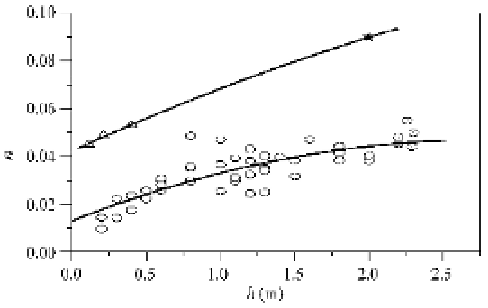Environmental Engineering Reference
In-Depth Information
4.3.3.9
Resistance and Drag Reduction in Pseudo-one-Phase Debris Flows
The resistance of a two-phase debris flow is much larger than for the flow of water. However, the resistance
of a pseudo-one-phase debris flow is sometimes lower than for the flow of water. Wang et al. (1999), assisted
by the Dongchuan Debris Flow Observation and Research Station, measured the roughness of clear water
flow in the Jiangjia Ravine, collected the resistance of pseudo-one-phase debris flows, and compared them,
as shown in Fig. 4.55. The resistance of debris flow is less than half that for clear water flow which means
that the velocity of debris flow in the gully is higher than 2 times that of clear water flow at the same flow
depths. This result implies a striking drag reduction in debris flow. There must be a special mechanism
resulting in the drag reduction.
Fig. 4.55
The Manning resistance coefficient,
n
, of clear water flows and pseudo-one-phase debris flows as a function
of flow depth,
h
, in the Jiangjia Ravine, Xiaojiang watershed on the Yunnan-Guizhou Plateau of China
Drag reduction is a focal point of research by scientists and hydraulic engineers, and sediment induced
drag reduction has been reported in the recent years. Chanson (1994) reported drag reduction resulting from
sediment and air bubbles. Wang et al. (1998) studied the resistance and drag reduction of hyperconcentrated
flow over rough boundaries and found that the drag reduction is due to the turbulence suppressing effect of
high concentrations and the smoothing of the boundary. Many parameters have been proposed to represent
resistance resulting from debris flow and none of them has been successfully applied to a specific flow.
If the pseudo-one-phase debris flow is homogenous and laminar, the resistance can be represented by
its rheological parameters such as viscosity and yield strength (Johnson and Rahn, 1970; Yano and Daido,
1965). Despite the much higher viscosity, the yield stress of debris flow means extremely higher resistance
rather than drag reduction. If the flow is turbulent, the resistance resulting from turbulent stress mostly
dominates the flow and there is no theoretical formula for the estimation of the resistance. The shape of
the channel and the bed form also contribute to the complexity of the problem. Hydraulic engineers have
applied the Manning roughness coefficient,
n
, to represent the resistance to the flow and experience has
been accumulated in the estimation of the roughness.
The drag reduction in debris flow is so obvious and is an important phenomenon receiving little
attention. The discharge of a debris flow gully, such as the Jiangjia and Dabaini gullies, is several times
higher than that of the Xiaojiang River into which they pour. Drag reduction is a cause of the extremely
high discharge.
The mechanism of the drag reduction is probably a result of the bed paving process. Figure 4.56 shows
a comparison of the bed surface before and after the bed paving process. The bed surface is obviously
smoother after the paving process. Another mechanism of drag reduction is due to air bubbles in the
debris mixture. Figure 4.57 shows the holes left by air bubbles in a debris flow deposit in a debris flow
gully in the Bailong River basin in Wudu County in Gansu Province.


Search WWH ::

Custom Search